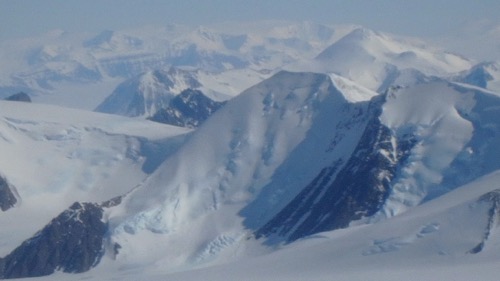Ice Shelves vs. Ice Sheets vs. Ice Tongue vs. Marine Ice
Ice shelves are found in polar regions, at the edges of ice sheets. They occur as land based ice sheets meet the ocean waters and float out away from the land. It might be hard to imagine such massive objects floating, but like any ice, their density is slightly less than water. Fresh water is also slightly less dense than salt water, as there is less "stuff" (in this case salt) to increase the density of sea water.
 Sea ice is frozen sea water while ice from ice shelves or tongues is "new" to the ocean system.
Sea ice is frozen sea water while ice from ice shelves or tongues is "new" to the ocean system.
Since ice shelves have already affected the sea level upon entering the ocean (think: ice cubes already in a glass will not raise water level when they melt), their melt will not really increase sea level. However, there is a small sea level increase because the volume of the sea water needed to displace a floating fresh water ice shelf is slightly less than the volume of the fresh water contained in the floating ice. But overall, this does not cause a large change in sea level.
 Ice on the land is thick, so as it reaches the ocean on a shelf, it has ability to add a lot of new water.
Ice on the land is thick, so as it reaches the ocean on a shelf, it has ability to add a lot of new water.
What DOES change and potentially greatly impact sea level is increased melt of glaciers upstream which can happen if the ice shelf melts quickly and allows the land glacier to advance and therefor melt. When an ice shelf holds back the uphill glacier feeding it, it is called "buttressing". This can happen because the ice shelf is pinned to rock along the side and/or bottom, and offers some stability to the system. An “ice tongue” can develop as a freely floating section of ice shelf that flows outward quite quickly and has no buttressing at all - imagine someone sticking their tongue out. Additionally, the ice shelf can freeze to sea water, leading to a mixture of types of ice called “marine ice”. Operation IceBridge looks closely at ice shelves to determine the contact and buttressing characteristics below the ice as well as the nature of each type of ice.
 Small areas of open water between ice reflect bright sunshine near the edge of the Southern Peninsula.
Small areas of open water between ice reflect bright sunshine near the edge of the Southern Peninsula.
Life Onboard
The incredible 6th graders at my school, Rocky Mountain School of Expeditionary Learning and their inspired teacher Lauren Cain made beautiful flags for me to bring along. Here, scientist Margi Turrin, ATM Co-PI John Sonntag, and mission engineer Matt Berry hold them up for a photo. These flags flew all over Antarctica! Thank you 6th grade for coming along with me to Antarctica!
 Made by RMSEL 6th graders, these flags flew over Antarctica!
Made by RMSEL 6th graders, these flags flew over Antarctica!
I was invited up to the cockpit for a wild ride over the Fleming Glacier today. It was the most incredible flight I have ever had, or probably will ever have. When Stu, our pilot, said "this is the most beautiful thing I've ever seen" you know it's special. Our pilots Stu Broce, Frank Batteas and Matt Pitch flew us at 15,000' over pointed mountain peaks jutting through bright blue glaciers - wow! When safety tech Lyn said "You're spoiled now" he wasn't kidding!
 The mountains along the southern peninsula are stunning!
The mountains along the southern peninsula are stunning!
 As we fly, we sometimes see our reflection. This helps us grapple with the sense of scale of the landscape.
As we fly, we sometimes see our reflection. This helps us grapple with the sense of scale of the landscape.
 The landscape is stunning, and from the cockpit, I can see 180+ degrees. Amazing!
The landscape is stunning, and from the cockpit, I can see 180+ degrees. Amazing!
Hanging out in the cockpit taught me a lot about why these skilled and adventurous pilots choose to work for NASA.
 Frank Batteas flies us through some rugged terrain, low and close to the mountains.
Frank Batteas flies us through some rugged terrain, low and close to the mountains.
 Pilot Stu had a fantastic time flying through the crazy terrain.
Pilot Stu had a fantastic time flying through the crazy terrain.
 So much going on in the cockpit.
So much going on in the cockpit.

Comments